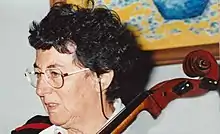Marion Créhange | |
|---|---|
 Créhange playing cello | |
| Born | Marion Henriette Caen 14 November 1937 Nancy (France) |
| Died | 28 March 2022 Vandœuvre-lès-Nancy (France) |
| Resting place | Vandœuvre-lès-Nancy |
| Education | licentiate, doctorate |
| Alma mater |
|
| Occupation |
|
| Awards |
|
| Academic career | |
| Fields | Computer science |
| Institutions |
|
| Thesis | |
| Doctoral advisor | Claude Pair, Jean Legras |
Marion Créhange (born Marion Caen; 14 November 1937 – 28 March 2022) was a French computer scientist. She was one of the first persons in France to get a PhD in Computer Science in 1961.[1][2][3][4]
A pioneer of computer science at the University of Nancy, she was one of the first to write a PhD in computer science in France in 1961, under the direction of Jean Legras. The title of her thesis is Structure du code de programmation, which deals with the definition and realization of a macro-assembler and a programming tool.
Appointed professor in 1976, she participated in the foundation of the teaching and research unit (UER) of mathematics and computer science at the University Nancy-I. She then turned to the design of database query languages and founded the Exprim (EXPert pour la Recherche d'IMages) research team. She became a member of the Académie de Stanislas in 2017.
Throughout her career, Marion Créhange has been committed to showing the reciprocal contributions between computer science and humanities. She advocates a computer science that promotes imagination and creation.
Her archives were deposited at the end of 2019 at the Henri-Poincaré archives of the University of Lorraine.
Career
Créhange took her doctorate at the University of Lorraine under Jean Legras. It was one of the first Computer Science PhD in France.[5] Her thesis was titled "Structure du code de programmation" ("Structure of programming code")[6][7][8] and it improved IBM's Symbolic Optimal Assembly Program by creating a macro-assembler.[8]
Créhange joined the CRIN (Center of Computer Science Research in Nancy) where she specialized in information systems. In 1983, she created the EXPRIM (Experts in Image Research) research group and she became a professor emeritus in the University, in the LORIA research lab.[4]
Créhange was a member of the Académie de Stanislas.[9][4]
See also
References
- ↑ "Structure du code de programmation, Thèse soutenue par Marion Créhange - Archives Henri-Poincaré". archives.ahp-numerique.fr. Retrieved 31 March 2022.
- ↑ "Marion CREHANGE". www.academie-stanislas.org.
- ↑ "Marion Créhange, première doctorante en informatique en France". Sciences et Avenir. 31 March 2022.
- 1 2 3 "Marion Créhange, première doctorante en informatique en France". Sciences et Avenir (in French). 31 March 2022. Retrieved 1 April 2022.
- ↑ La Gazette des archives (in French). Association des archivistes français. 1970. Retrieved 31 March 2022.
- ↑ "Structure du code de programmation, Thèse soutenue par Marion Créhange - Archives Henri-Poincaré". archives.ahp-numerique.fr. Retrieved 31 March 2022.
- ↑ "Trois mille ans d'informatique". CNRS Le journal (in French). Retrieved 31 March 2022.
- 1 2 "Une science encore incertaine: l'émergence de l'informatique dans la recherche et l'enseignement supérieur français". www.epi.asso.fr. Retrieved 31 March 2022.
- ↑ "Marion CREHANGE". www.academie-stanislas.org. Retrieved 31 March 2022.